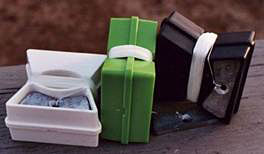The Fisherman's Marker
By Paul Strege
"Marker buoys
- who needs them?!" That is what I once
thought and have heard throughout my fishing lifetime. Until I stumbled
upon an innovative version of the traditional gaudy fluorescent orange
and yellow "jugs" a few years ago, I avoided using them
all-together. Fishing markers are largely unpopular with many anglers
today for two reasons: often they attract more anglers to a specific
location, and they occupy a relatively large amount of valuable space
in a tackle box or storage compartment.
Jeff Lamphere from Minnetonka, Minnesota invented a solution. He calls
it the Fisherman's Marker. Not only are these markers dramatically
smaller in size than traditional buoys, they also come in non-attractive
colors. The smaller size and flat design occupies less space and allows
for ease in stowage. Non-attractive colors meanwhile provide camouflage
from other anglers: white for sunny days, and black for low-light conditions.

Above: The Fisherman's Marker. They measure 2-1/2" x
2-1/2" x 1-1/2" and come in colors white, lime green
and black. |
Jeff started development on the Fisherman's Marker while fishing
at his cabin on Green Lake in Spicer, Minnesota. One of his favorite
fishing spots on the lake was a small, shallow rock bar located one
mile offshore. Water depths of 40 to 50 feet surrounded the bar, making
it a prime spot for fishing. "Once we located the rocks, we would
mark it with a buoy. If you ran your motor over the rock pile more
than once, you would scare the fish and push them into deeper water - generally
not getting them to bite," recalls Jeff. "After we marked
the rock pile, we would float quietly over it and catch fish on every
drift, mostly nice walleyes and smallmouth bass."
With Jeff's
success came undesirable attention, however. "It
seemed like within minutes of throwing a marker buoy, our spot would
become Grand Central Station. As soon as other fishermen saw our float
they would motor up to it to check the depth and many times start fishing
extremely close to the buoy marker we had thrown out - ultimately spooking
the fish and our bite would be over."
It was after this repeated
occurrence that Jeff decided to look for a small discrete marker that
people would not notice - one that
would not attract other fishermen in the area. After a fruitless search,
he decided to fabricate one of his own out of a small block of wood,
painted white. That small block served Jeff well the rest of that summer
and fall, eliminating artificially-crowded spots. Thus began the initial
development of the Fisherman's Marker.
The Fisherman's Marker
today has certainly evolved from the first prototype, yet it remains
a secret tool among weekend anglers and tournament fishermen alike.
Jeff receives new testimonials and creative on-the-water applications
every month. Anglers can pinpoint the exact locations of underwater
structure, breaklines, and even bedding bass. Smaller, more compact
markers offer the angler the additional ability to efficiently mark
structure with the placement of multiple buoys as opposed to fewer
deployments of larger, traditional ones.
Structure
While Global Positioning Systems ( GPS) continue to evolve, the marker
buoy serves an important role that cannot be replaced by modern technology.
An angler often has to traverse, or crisscross a single weedline multiple
times in order to locate a defined edge. As a result, the tracking
display becomes an indistinguishable conglomeration of trails. Global
Positioning Systems are limited in this capacity. Deployed markers,
on the other hand, offer a concise, visual delineation of the underwater
structure.
Team Kellogg's Pro Dave Lefebre of Erie, Pennsylvania
uses the Fisherman's Marker in this capacity. "When fishing a weedline,
I like to place markers along the edge that I am targeting. I will
have several markers out at a time - six or more for a single stretch.
The neat thing about the Fisherman's Marker is that their compact
size allows me to easily carry a dozen in the boat at a time."

Photo courtesy of FLW Outdoors |
Dave will also customize his marker by cutting the pre-spooled line
to a specific length. This ensures that his marker will not completely
unroll in large waves. "I organize my markers in sets, generally
in 5-foot increments, with the depth clearly marked on top. Even before
heading to the lake, if I know that the weedline is generally 8-feet
deep, I will pack my 10-footers."
Sight Fishing
Sight fishing for bedding bass is not a technique that anglers commonly
associate with marker buoys. Bass are easily spooked during certain
phases of the spawn. If an angler has to target bedding bass at a distance,
or at a greater depth, placing a marker buoy can establish a floating
landmark in low visibility conditions. Light refraction also is a common
challenge for sight fishermen, especially in deep water. The actual
position of a bass has to be interpolated with every cast to compensate
for the refracted image. With a definitive point of reference, anglers
can be assured of proper lure position and focused on provoking the
bass into a strike.
Boat Position
Another useful application of the Fisherman's Marker does not
include marking structure at all; it is position triangulation. An
angler can drop a buoy off the bow, and have an immediate reference
point for use in conjunction with two aligned features onshore. With
a marker buoy aside the boat, a second set of features is not needed
for triangulating a spot. Similarly, when an angler locates an active
school of fish offshore, simply dropping a marker over the edge is
both practical and quick. There is no need to throw a marker into the
active school, and the precious time saved stumbling back to the console
GPS unit can be spent landing additional fish.
While fishing tools come
and go, there are an innovative few that deserve a permanent place
in any angler's tackle box. The patented
Fisherman's Marker is one tool no angler should be without. For
more information on the Fisherman's Marker, visit Jeff's
website at www.fishermansmarker.com,
or call: 612-965-2259.

